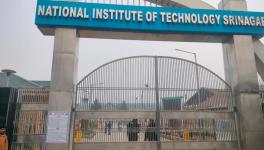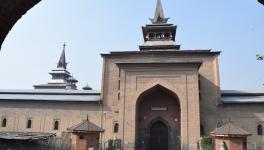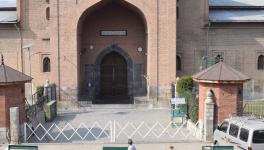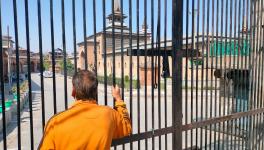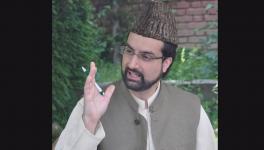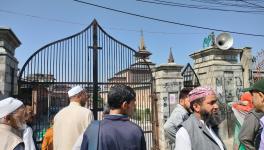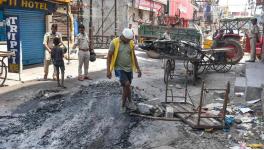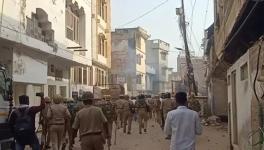Ranchi Violence: Who Triggered June 10 Violence During Prophet Row Protest?
This is the concluding part of the two-part report on the communal violence in Ranchi, Jharkhand, on June 10, and its aftermath. The writer has spoken to members of both communities, administration/police representatives, and local observers/journalists. Videos and posts on social media in the run-up to the violence have been reviewed and quoted but their authenticity cannot be independently verified by Newsclick.
Ranchi (Jharkhand)/New Delhi: Who triggered the violence in Ranchi where two youth were gunned down allegedly by the police — which opened indiscriminate fire on June 10 to control a crowd of thousands protesting against the offensive remarks on Prophet Mohammad by now suspended BJP leaders Nupur Sharma and Naveen Kumar Jindal?
A NewsClick investigation into the incident raises more questions than answers.
Maulana Qutubuddin Rizvi, secretary general of the Jharkhand Idara-e-Shariah, claimed there was no call for any protest march by any religious outfit of the state. He even claimed “people were urged to go back to their homes after the Friday congregational prayer”.
He went on to allege that Muslims were targeted by the police with an intention to kill them.
“The firing was opened by the administration without giving warnings. There were other measures to control the crowd, but the police did not use them. There are cases where protesters have received multiple gun shots. This suggests that the intention of the police was not right. What explains the use of lethal weapons AK-47 against the protesters. You (the police) were not fighting terrorists,” he told NewsClick over the phone.
It has been so many days, he said, since the indecent comments were made, but the BJP spokesperson (Nupur Sharma) has not so far been arrested.
“It is natural that when religious sentiments are hurt, people will take to the streets. There were common people on the road. It was the responsibility of the administration to control them without killing them,” he added, claiming that the protesters were returning after burning the effigy of Nupur Sharma, but were attacked with stones.
However, his claim could not be independently verified.
Asked how such a huge crowd hit the streets without any mobilisation, the Maulana said: “If religious sentiments get hurt, a crowd of not just 2,000-4,000 but 2-4 lakh will come on the roads. Even if it is assumed that the protest was unlawful, was it okay to shoot at the protesters? Everyone was demanding Nupur Sharma’s arrest, but it did not happen. This angered the people who came out to register their protest.”
Asked if it was not the responsibility of the Muslim clergy to control the crowd and ask them not to go on rampage, he said: “People have different opinions. Some may support protest marches, while others may favour it. But if civilians come on the road, it is the responsibility of the police to protect them and ensure there is no vandalism anywhere. It is the complete failure of the law enforcement agencies. If the first stone is thrown on the crowd, it will naturally agitate the crowd.”
Recall that after the Friday prayer on June 10, people in thousands gathered near the Iqra Masjid along the Main Road (MG Road) and marched toward Firayalal Chowk. As the procession reached the Hanuman temple opposite to the Daily Market, stone pelting began.
After resorting to lathi-charge, the police first lobbed tear gas shells and then began firing bullets on the agitators allegedly without any warning.
Iqra Masjid is counted among Ranchi’s big and famous mosques. The areas surrounding it are considered to be sensitive, as these have witnessed communal tension several times in the past during religious processions.
If this was so, why were the protesters allowed to move ahead in the first place?
After talking to local residents, activists who visited the areas post violence, eye witnesses and local journalists, it emerged that people were mobilised for the demonstration through Facebook and WhatsApp. Who initiated it, nobody knows. If messages, appealing to people to take part in a rally after the Friday prayer, were circulating on the Internet, wasn’t the police unaware? If not, why?
And if the police had prior knowledge with regard to the same, why was not there adequate deployment to stop the agitators?
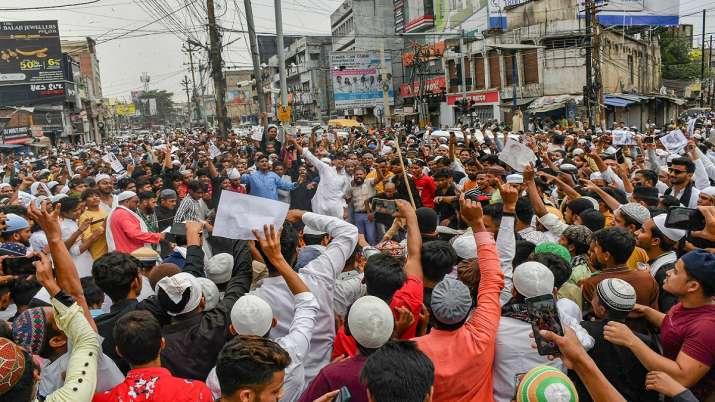
Replies to these queries could not be obtained as senior police officials kept passing the buck.
Obaidullah Qasmi, prayer leader at Iqra Masjid, categorically said that there was no call for any such protest by any social or religious organisation.
“Someone had posted an appeal asking people to hold a protest march on Friday. When it was brought to my knowledge, I clarified on the social media on Thursday itself, a day before the procession, clearing the air that there is no such call by any organisation. I urged people not to pay heed to such posts. The next day, during the Friday sermon, I told people there is no announcement of bandh or protest demonstration by any religious organisation. Therefore, they should go back to their houses after the prayer. We should not indulge in any activity that may disturb the peace and tranquillity,” he said.
Such an appeal, Maulana Qasmi, too reiterated, was made from all mosques in the city. “The police administration was also alerted in advance,” he claimed.
So, how did such a large crowd gather even after appeals and announcements from all the mosques? In response, the cleric said: “This is a lapse on the part of the police. They did not take the information regarding a possible protest rally seriously. The social media post was viral, but it failed to grab the eyeballs of the police officials and their intelligence gathering units? It is not that the police was completely unaware.”
Asked who was behind the viral social media message, he said: “It is a matter of investigation. The police must impartially probe and take action against whosoever is found guilty. At the same time, indiscriminate police firing should also be investigated to fix accountability.”
In their complaints to the police, the fathers of both the deceased youth alleged that people from the terrace of the temple were throwing stones and firing bullets on the protesters. They went on to claim that the trouble started from the temple roof, and the protesters retaliated after they were attacked.
Pervez Alam, father of deceased Mudassir Alam, 16, has named a few individuals, including one Bhairav Singh, in his complaint — claiming they were pelting stones and firing bullets on protesters from the temple roof top.
Singh is a Hindutva extremist in Ranchi who is notorious for his hate speeches and giving calls for economic boycott of Muslims. He hit headlines after he attacked Chief Minister Hemant Soren’s convoy last year. He is at present out on bail.
NewsClick analysed several video footage in support of the allegation, but they are not clear enough to support the claims.
Shyamnand Pandey, the temple priest, when asked to narrate the sequence of events that unfolded that day, alleged it was the protesters who first threw stones toward the temple.
“I was in the temple at that time. The crowd burnt the effigy. All of a sudden, 5,000-10,000 protesters gathered here. A maximum of 40 policemen were present at that time who failed to control the huge crowd. The mob surrounded the temple from all sides and pelted it with stones because several people were taking shelter here. They also included policemen,” he claimed.
Asked about allegations that the protesters were first attacked with stones and bullets from the terrace of his temple, the 30-year-old said: “This is wrong. We did not pelt a single stone. There were policemen and journalists who had come inside the temple to save themselves. It is possible that they may have responded to the rioters with the same stones thrown towards the temple.”
When asked who apart from the cops and journalists were there inside the temple and how many people were taking a shelter there, Pandey claimed that at least 13 people were inside when the procession reached Daily Market. The number increased after the police and journalists too joined, he added.
Was Bhairav Singh also present in the temple at that time? The priest in response said: “We have CCTV cameras installed both at the temple’s entry and exit. I can say with responsibility that no outsider was present inside the temple before the violence. Also, no one threw stones from the first floor. That’s for sure. I don’t know about the third floor or the terrace.”
Singh denied the allegations levelled against him. “I was at home throughout the day on June 10. I was not there. Check out my cell phone location. Local people know me. Had I been present there, I would have featured in the video footage or photos. Take out the CCTV footage and check it. This is a false allegation against me. Anti-social elements are trying to tarnish my image,” he told NewsClick.
WHAT EYEWITNESSES SAY
A number of eyewitnesses this reporter spoke to said the crowd was charged and wanted to go toward Firayalal Chowk on the Main Road. When elders and responsible people tried to convince them not to go ahead with the rally, they said, they were misbehaved with.
“Not more than 10 policemen were deployed near Iqra mosque despite the possibility of a protest march. Had there been strong deployment, the incident would have been easily averted. The administration knew that this was going to happen tomorrow. But the administration did not take any action,” they said, requesting anonymity.
Giving a blow by blow account of what happened that day after the congregational prayer, some eyewitnesses said: “The crowd outside the mosque swelled in no time after the prayer was over. People from surrounding areas, such as Doranda, Hindpiri, etc., assembled there. Shouting slogans, the crowd started moving toward Firailal Chowk. The police attempted to stop them by barricading the road, but the crowd pushed them aside and continued to move ahead. As the procession reached the Daily Market taxi stand, there was a commotion and stone-pelting began. A bamboo was hurled on the protesters in such a way that live electricity wire passing from the area fell on the agitators. But that attempt failed. Who threw the first stone, it is very difficult to ascertain.”
The other group of eyewitnesses contradicted the allegation, arguing that the stones were hurled by “trouble makers” on the police and local Hindu residents. “When we ran into the Hanuman temple to save our lives, they began attacking the religious place as well,” said one of them.
There are reports that pamphlets were also distributed, urging people to take out the procession. But the name of any organisation was not mentioned on the pamphlets. In addition, an announcement was also made. NewsClick could not find any such pamphlet.
Refusing to be identified, a person said a message, claiming that a complete closure will be observed across the country on June 10, was circulating on WhatsApp and Facebook that day. He even showed the viral anonymous message on his cell phone, but refused to share it with anyone.
“We too held a meeting and requested the shopkeepers to keep their business establishments closed on June 10. We even went from shop to shop and urged people to support the strike. But we did not make any appeal to take out the procession. All the traders unanimously agreed to support the closure. Almost the entire Daily Market was closed on Friday,” he said.
The person further claimed that a letter was also viral on Facebook and WhatsApp wherein it was written that a protest rally would be organised from near Iqra Masjid till Firayalal Chowk. But he had no evidence to prove it. Asked if he has that letter, he said: “No, I don’t have it. But it was making rounds on the Internet.”
Asked who had given the call for the bandh and why they held a meeting to urge shopkeepers to observe the strike, he said: “We do not know whose call it was. Since it aimed at registering a peaceful protest against the insult of our Prophet, we found no harm in making an appeal for just a closure, not any demonstration.”
A third message was also reportedly viral on WhatsApp, requesting the print and electronic media in Ranchi to cover a protest demonstration to be held on June 10. Circulated from Bokaro, over 100 kilometre away from the capital city of Ranchi, the message read: “After Friday prayers on June 10, at 1.45 pm, the Muslim community will march from near Iqra Masjid at Main Road to demand the central government that Nupur Sharma be put behind bars. Muslims across the country and abroad are staging protests and getting FIRs registered against her.”
When contacted, a man, requesting anonymity, confirmed that the viral invitation to the media was sent by him.
“I had gone to offer Friday prayers at Iqra Masjid where I heard from people about the procession. I dialled one of my acquaintances, who is a journalist, to enquire if he has any such information. His denial prompted me to write the letter for media coverage and shared it on various WhatsApp groups,” he said.
Asked how he informed the media about the possible procession without any confirmation, he said: “A Bharat Bandh call was already viral on the social media, and people were even circulating it in different WhatsApp groups” as was the viral call for strike issued by any religious or social organisation. He admitted his fault. “I made a mistake. I sent it to the media without verifying it. This is my fault,” he said.
Two Ranchi-based journalists who have been covering the incident since it happened, described what actually transpired that day.
“The Daily Market traders had unanimously decided to keep their business activities shut to register their protest against the denigration of Prophet Mohammad. They also planned to march silently without raising any slogans, but the programme to hold the protest rally was cancelled following a meeting with the police administration a night before. As decided, the closure was peacefully being observed,” Asghar Khan, a journalist, told NewsClick.
After Friday prayers, Khan said, an unexpectedly huge crowd gathered near Iqra mosque along the Main Road. “The participants of the gathering were not older than 21-22 years. How did they assemble in such a large number? Who mobilised them? All these are a matter of investigation. But there was some sort of mobilisation for sure. WhatsApp messages were being circulated and social media posts were making rounds on the Internet asking people to protest in large numbers,” he said.
When the crowd moved toward the Main Road and reached the Daily Market in the form of a procession, there are allegations that stones were pelted on them from above the Hanuman temple and shots were fired. “But there is no solid evidence to prove it,” he clarified.
Anand Dutta, another journalist, said it’s difficult to find out who threw stones first. But one thing, he said, is crystal clear that it is the serious lapse on part of the police.
“If there was mobilisation, what was the local intelligence doing? If there was actionable intelligence, why was adequate police deployment not there? Why was multi-layering not done to stop the protesters from going ahead? Why was a disproportionate police force used?” he asked.
Dutta said the police were claiming that several rounds were fired at them by the protesters with an intent to kill, who are the policeman who received the bullets?
Both journalists said police deployment was too thin to control a crowd of thousands.
The police claimed they, too, suffered injuries, but it is not known, except in one case, as to where they are undergoing treatment and what kind of injuries they got.
If locals are to be believed there was a strong crowd of 3,000 to 5,000 people, but the police put this number at 8,000 to 10,000.
“There are video clips wherein policemen and journalists can be seen running into the temple premises for shelter. There is also video evidence, showing a few people standing on the terrace of the temple. But it’s not clear whether or not they were pelting stones,” he added.
Dutta also said there were journalists and extremists on the spot who were instigating and guiding the police where to fire and whom to kill.
“In the presence of the police, they were inciting people to kill Muslims and set their business establishments on fire. They were also asking the police to fire in different directions,” he alleged.
‘KILL THE PAKISTANIS’
Among the viral videos of the incident, some journalists can be heard making highly objectionable comments against the protesters and asking the police to lathi-charge and shoot them.
One such journalist was Ashok Gope who, during a Facebook live on the stone-pelting, can be heard, saying: “This picture is from Ranchi. It is reminiscent of Kashmir, where stone-pelters indulge in brick batting. People are playing havoc in the name of Islam and hooliganism is at display. This is the real face of Islam. Terror is being unleashed in the name of Islam. Who is responsible for it?”
He then shouts, “Hit...there is bloodshed in the name of Islam.”
Amidst the sounds of continuous police firing, he can be heard asking the cops, “Fire at them. What are you doing? Your action will yield nothing, it will end as it is. Go ahead and fire, targeting them.”
Others also can be seen and heard, inciting the police for shooting the protesters dead.
Gope once again shouts: “Come on, go ahead. Pakistanis are apparently living in the Daily Market area. Shoot them, kill them.”
He continues to hurl abuses on the protesters and asks the police to break into their shops. He can be heard, saying the same in his entire 40-minute video — which he had posted on his Youtube channel Mukher Samvad.
The video is also available on his Facebook timeline. Gope could not be reached for comments.
WAS OPENING FIRE THE ONLY OPTION?
On June 12, two days after the violence, Ranchi Deputy Commissioner Chhavi Ranjan defended the police action and said the police opened fire at the protesters as it was the “last resort.”
“It was needed to control and disperse the mob because it was the last resort,” he said, claiming that the standard operating procedure was “strictly followed” and that the magistrate had to take the strict decision under the “unavoidable circumstances”.
When asked what led them to take the extreme decision instead of following the SOP (lathi-charge, teargas shelling, use of water cannons, etc.), an officer of the rank of deputy SP said: “It’s very easy to criticise the police action. Decisions are made to maintain order by analysing the rapidly changing ground situation. Once you review the turn of events, you will understand why it was unavoidable. It would not be fair for us to say now on how correct and logical our action was as the matter is being investigated.”
(Concluded)
Get the latest reports & analysis with people's perspective on Protests, movements & deep analytical videos, discussions of the current affairs in your Telegram app. Subscribe to NewsClick's Telegram channel & get Real-Time updates on stories, as they get published on our website.









